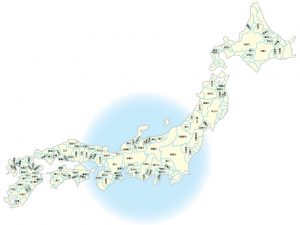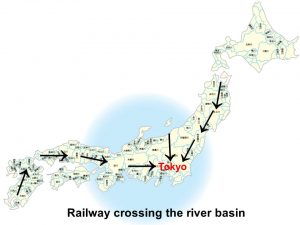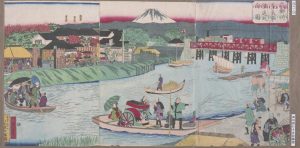━━━━━━━━━━━━━━━━━━━━━━━━━━━━━━━━━━━
【JWF News Vol. 175】Flood Fighting Drill Tour 2019
22 May 2019
━━━━━━━━━━━━━━━━━━━━━━━━━━━━━━━━━━━
◇ Contents ◇
・Foreword Mystery in Modernization of Japan – from the river basin feudalism to the centralized system
・Announcement from the Japan Water Forum
– JWF Fund 2019 will be open for applications!
・Report from the Japan Water Forum
– The 1st Joint Steering Committee of the 4th Asia-Pacific Water Summit
– Flood Fighting Drill Tour 2019
– JWF Fund 2018 Completed!
━━━━━━━━━━━━━━━━━━━━━━━━━━━━━━━━━━━
・Foreword Mystery in Modernization of Japan – from the river basin feudalism to the centralized system
By Kotaro Takemura, Chair of the Japan Water Forum
━━━━━━━━━━━━━━━━━━━━━━━━━━━━━━━━━━━
On the 1st of May, Japan’s new His Majesty the Emperor succeeded to the Imperial Throne and the new Reiwa era began. This is indeed a valuable opportunity for Japanese people to talk about Japan and renew the understanding of its history. His Majesty the Emperor of Japan is in the highest position in the upper structure of the country. In this issue, I would like to share some thoughts about the Japanese society from the lower-structural perspectives as an expert of infrastructure.
Toynbee’s Quote
“One of the miracles in human history is the modernization of Japan after the Meiji era”
This is a quote made by Arnold J. Toynbee who was a British historian, born in 1889 and died in 1975. This brilliant historian made a firm statement that Japan’s modernization is one of the miracles of the world. The mystery lies in why a country of centralized feudal system could catch up with the western civilization in short bursts and attain the modernization?
River Basin Feudal Society in the Edo Era
Japanese islands form extremely distinctive geographical landscape.
The Japanese archipelago has a mountainous backbone from which myriad rivers flow down to the Japan Sea and the Pacific Ocean. People came to settle in river plains for wet-paddy rice agriculture, which plains are divided by mountains, straits and rivers.
The Edo Government (1603 – 1868) contained provincial feudal loads within the river basins divided by such land features. The figure 1 shows a river basin classification drawing of the Japanese islands. The contained feudal loads in such river basin areas obtained new lands and hoarded wealth by building levees and drawing water from rivers to develop agricultural fields to strengthen the foundation of their local administrations. This consequently supported the centralized feudalism of the Edo Government. Speaking from the infrastructural perspective, I think this social system could be called as “river basin feudalism”. However, the robust river basin feudalism was the largest impediment for upcoming modernization.
 |
| Figure 1 |
Transition from Feudalism to Centralized Power
In those days, various powerful empires abroad had successively colonized local countries in Africa, Middle East, South Asia, Southeast Asia and the Pacific islands one after another. The basic principle of the imperial policy for colonization is “Divide and Rule”. That is, by breaking up the larger concentrations of power into pieces and then fomenting antagonism among them to develop into a civil war, the imperial powers could exploit the debilitated nations and establish a puppet regime. This was how they gained the power over the regions.
In this context, Japan’s centralized feudalism of the Edo Government presented the best favorable opportunity for the imperial countries. What needed for them to start the imperial invasion was simply alluring feudal loads in local domains to break out a civil war.
That should not ever happen to Japan and must be avoided by all means thought the Meiji Government. Therefore, the government decided to undermine the feudal loads in the provinces and centralize the dispersed power and wealth across Japan into Tokyo in order to prevent it from becoming a prey, so that they could develop the country. That is the basic policy of the Meiji Government.
This also meant that, as the Japanese feudal society adapted to the geography of river basins, Japan had to get out of the strong localism that had been formed by the shape of river basins. In the midst of such circumstances, those who could make it happen from infrastructural aspects appeared. Infrastructure machinery emerged and penetrated the river basins divided by straits, mountains and rivers and facilitated concentrating assets and people in Tokyo: a steamed locomotive.
Impact Shock of Railroad
Shigenobu Okuma and Hirobumi Ito played a central role in pursuing the railroad scheme. The traveling time between Tokyo and Yokohama City had used to taking around several hours but the railroad enabled people to travel the same distance only within an hour.
The figure 2 shows a steamed locomotive running across the Tama River. Previously, the Tama River and the Tsurumi River were distinctive borders dividing the areas but the steamed locomotives quite easily went across the border. This caused the rivers’ function being a border line to disappear.
|
|
|
Figure 2 |
Toshimichi Okubo, then equivalent to the Prime Minister of Japan, was a clever man who instantly understood the shocking impact of the railroad in the society. Though severely opposing the construction of the railroad initially, he realized the importance of the locomotives once on getting on it. He later described in his journal that seeing is believing and that he really enjoyed riding the train. He wrote, “Without development of the railroad, the nation cannot be developed.”
Since then, Toshimichi Okubo changed the direction to increase investment in the railroad construction at once. Within some 30 years since the opening of the railroad between Shimbashi and Yokohama Stations, the railroad extended its length to over 7,000 kilometers from Hokkaido to Kyushu.
The figure 3 shows the railroad network bound to Tokyo. Ambitious young people and financial resources jumped into the band wagon, drawing everything into Tokyo.
 |
| Figure 3 |
Collapse of River Basin Feudalism
The river basins divided by geographical features had supported the feudal society in the era of Edo. However, the basins were penetrated by the railroad and the Japanese islands were unified as one centralized nation.
In this way, the Japanese society drastically changed its system from feudalism to the Tokyo-centered country. Concentering human and financial resources into Tokyo, Japan became firm and strong. People worked together and started companies. People enthusiastically discussed about democracy, constitutions and parliamentary system, which eventually led Japan to become the last imperial power in the world history.
In 1872, a steam locomotive gave its first whistle at Shinbashi Station.
The whistle was a sign of farewell to the river basin society Japanese people had been accustomed to for long time. It was a signal as well for the beginning of the modern civilization of over concentration in central Tokyo.
In other words, the disappearance of the river basin society is one of the elements for the miracle modernization of Japan that marveled Toynbee.
━━━━━━━━━━━━━━━━━━━━━━━━━━━━━━━━━━━
・Announcement from the Japan Water Forum
━━━━━━━━━━━━━━━━━━━━━━━━━━━━━━━━━━━
– JWF Fund 2019 will be open for applications!
The JWF Fund was founded in 2005 and solely operated by Japan Water Forum (JWF), which aims to support selected grass-roots organizations in developing countries who have been addressing water-related issues in their own countries. Every year, JWF publicly seeks for projects and those adopted after due assessment will be eligible to get funding up to 1,000 USD per project.
The JWF Fund is based upon membership fees of the JWF members and donations from general contributors through the Charity for Water run by JWF.
Japan Water Forum will start to call for application for the JWF Fund 2019.
The application period for this year is 3 June to 6:00 p.m. 15 July, 2019 in Japan time.
We are going to select 6 to 7 projects this year.
To apply for the fund, please read through the guidelines beforehand and use the prescribed application form.
We hope that it will become a certain step to solve water-related issues at the grass-roots level.
We look forward to receiving your applications!
▼Please visit the following website for details▼
https://www.waterforum.jp/all/grass_roots_projects/jwf/2019/0515/?p=11194tag=en,rep_en
━━━━━━━━━━━━━━━━━━━━━━━━━━━━━━━━━━━
・Report from the Japan Water Forum
━━━━━━━━━━━━━━━━━━━━━━━━━━━━━━━━━━━
– The 1st Joint Steering Committee of the 4th Asia-Pacific Water Summit
The Asia-Pacific Water Forum (“APWF”, Secretariat: Japan Water Forum) and the City of Kumamoto held the 1st Joint Steering Committee of the 4th Asia-Pacific Water Summit (“4th APWS”) on Thursday, 18 April 2019 (Chair: Kotaro Takemura, Chair of Japan Water Forum (“JWF”); Vice-Chair: Kazufumi Onishi, Mayor of Kumamoto City) aiming for smooth operation of the 4th APWS.
In this three-hour committee meeting, staff members of JWF, which is the secretariat of APWF, and the City of Kumamoto discussed agendas including the bylaws, accounting procedures of the committee, the programme concept of the 4th APWS as well as a framework of the session topics.
▼Read more▼
https://www.waterforum.jp/all/policy_recommendations/apws/2019/0521/?p=11267
(Reported by Natsuko Uemura, Manager)
————————————————————————————————————————
– Flood Fighting Drill Tour 2019
On May 18, the 68th Flood Fighting Drill in the Tonegawa River Basin took place, in the City of Ashikaga, Tochigi Prefecture. This drill is aimed at handing down Japan’s traditional flood prevention techniques and raising public awareness of flood prevention. The JWF has been holding the Flood Fighting Drill Tour since 2006 for officials from embassies and international organizations in Tokyo, with the aim of transmitting information to the rest of the world about our experience and the lessons learnt from water disasters, as well as traditional flood fighting activities carried out by local residents.
▼Please visit the following website for details▼
https://www.waterforum.jp/all/transmitting_japanese/flood_fight/2019/0521/?p=11177
(Reported by Naomi Kato, Coordinator)
————————————————————————————————————————
– JWF Fund 2018 Completed!
The JWF Fund was founded in 2005 and solely operated by Japan Water Forum (JWF), which aims to support selected grass-roots organizations in developing countries who have been addressing water-related issues in their own countries. Every year, JWF publicly seeks for projects and those adopted after due assessment will be eligible to get funding up to 1,000 USD per project.
The JWF Fund is based upon membership fees of the JWF members and donations from general contributors through the Charity for Water run by JWF.
The JWF Fund 2018 was conducted where 7 projects from 5 countries were selected out of 408 projects submitted from 41 countries.
▼Please visit the following website for details▼
https://www.waterforum.jp/en/whatwedo_en/grassroots_p_en/2018/0531/?p=9005
(Reported by Sae Ishihara, Chief Manager and Akie Gunji, Assistant Manager)
━━━━━━━━━━━━━━━━━━━━━━━━━━━━━━━━━━━
▼JWF News Archives▼
https://www.waterforum.jp/all/newsletter?tag=en,rep_en
If you wish to post information on our bulletin board, or should you prefer not to receive further JWF News, please contact us.
You can also get in touch regarding subscribing, changes of address, or any other comments or requests.
■━━━━━━━━━━━━━━━━━━━━━━━━━━━━━━━━━■
JWF News Vol. 175 / 22 May 2019
Japan Water Forum
6th fl., 5-4 Nihonbashi-Hakozaki-cho, Chuo-ku, Tokyo, 103-0015
TEL: 03-5645-8040 FAX: 03-5645-8041
E-mail: news[at]waterforum.jp URL: https://www.waterforum.jp/en/
※Please change [at] to @
■━━━━━━━━━━━━━━━━━━━━━━━━━━━━━━━━━■

